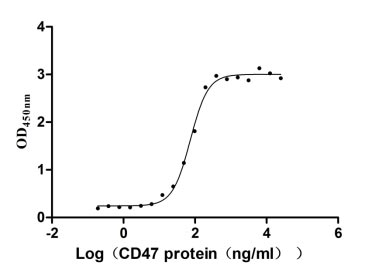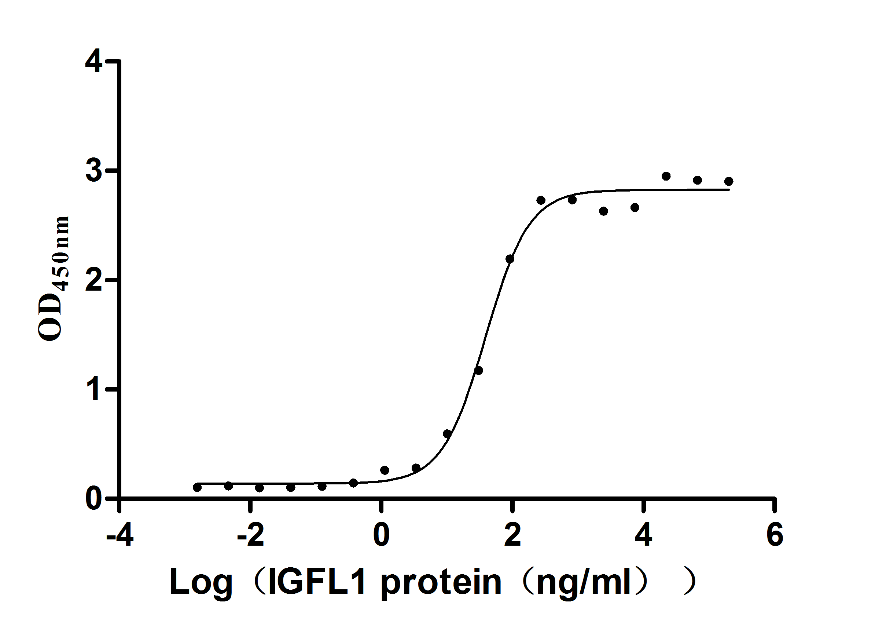Recombinant Human Serine/threonine-protein kinase tousled-like 1 (TLK1)
-
货号:CSB-YP891950HU
-
规格:
-
来源:Yeast
-
其他:
-
货号:CSB-EP891950HU
-
规格:
-
来源:E.coli
-
其他:
-
货号:CSB-EP891950HU-B
-
规格:
-
来源:E.coli
-
共轭:Avi-tag Biotinylated
E. coli biotin ligase (BirA) is highly specific in covalently attaching biotin to the 15 amino acid AviTag peptide. This recombinant protein was biotinylated in vivo by AviTag-BirA technology, which method is BriA catalyzes amide linkage between the biotin and the specific lysine of the AviTag.
-
其他:
-
货号:CSB-BP891950HU
-
规格:
-
来源:Baculovirus
-
其他:
-
货号:CSB-MP891950HU
-
规格:
-
来源:Mammalian cell
-
其他:
产品详情
-
纯度:>85% (SDS-PAGE)
-
基因名:TLK1
-
Uniprot No.:
-
别名:PKU beta; PKU-beta; serine threonine protein kinase; Serine/threonine protein kinase tousled like 1; Serine/threonine-protein kinase tousled-like 1; SNARE protein kinase SNAK; Tlk1; TLK1_HUMAN; Tousled like kinase 1; Tousled-like kinase 1
-
种属:Homo sapiens (Human)
-
蛋白长度:full length protein
-
表达区域:1-766
-
氨基酸序列MSVQSSSGSL EGPPSWSQLS TSPTPGSAAA ARSLLNHTPP SGRPREGAMD ELHSLDPRRQ ELLEARFTGV ASGSTGSTGS CSVGAKASTN NESSNHSFGS LGSLSDKESE TPEKKQSESS RGRKRKAENQ NESSQGKSIG GRGHKISDYF EYQGGNGSSP VRGIPPAIRS PQNSHSHSTP SSSVRPNSPS PTALAFGDHP IVQPKQLSFK IIQTDLTMLK LAALESNKIQ DLEKKEGRID DLLRANCDLR RQIDEQQKLL EKYKERLNKC ISMSKKLLIE KSTQEKLSSR EKSMQDRLRL GHFTTVRHGA SFTEQWTDGF AFQNLVKQQE WVNQQREDIE RQRKLLAKRK PPTANNSQAP STNSEPKQRK NKAVNGAEND PFVRPNLPQL LTLAEYHEQE EIFKLRLGHL KKEEAEIQAE LERLERVRNL HIRELKRINN EDNSQFKDHP TLNERYLLLH LLGRGGFSEV YKAFDLYEQR YAAVKIHQLN KSWRDEKKEN YHKHACREYR IHKELDHPRI VKLYDYFSLD TDTFCTVLEY CEGNDLDFYL KQHKLMSEKE ARSIVMQIVN ALRYLNEIKP PIIHYDLKPG NILLVDGTAC GEIKITDFGL SKIMDDDSYG VDGMDLTSQG AGTYWYLPPE CFVVGKEPPK ISNKVDVWSV GVIFFQCLYG RKPFGHNQSQ QDILQENTIL KATEVQFPVK PVVSSEAKAF IRRCLAYRKE DRFDVHQLAN DPYLLPHMRR SNSSGNLHMA GLTASPTPPS SSIITY
-
蛋白标签:Tag type will be determined during the manufacturing process.
The tag type will be determined during production process. If you have specified tag type, please tell us and we will develop the specified tag preferentially. -
产品提供形式:Lyophilized powder
Note: We will preferentially ship the format that we have in stock, however, if you have any special requirement for the format, please remark your requirement when placing the order, we will prepare according to your demand. -
复溶:We recommend that this vial be briefly centrifuged prior to opening to bring the contents to the bottom. Please reconstitute protein in deionized sterile water to a concentration of 0.1-1.0 mg/mL.We recommend to add 5-50% of glycerol (final concentration) and aliquot for long-term storage at -20℃/-80℃. Our default final concentration of glycerol is 50%. Customers could use it as reference.
-
储存条件:Store at -20°C/-80°C upon receipt, aliquoting is necessary for mutiple use. Avoid repeated freeze-thaw cycles.
-
保质期:The shelf life is related to many factors, storage state, buffer ingredients, storage temperature and the stability of the protein itself.
Generally, the shelf life of liquid form is 6 months at -20°C/-80°C. The shelf life of lyophilized form is 12 months at -20°C/-80°C. -
货期:Delivery time may differ from different purchasing way or location, please kindly consult your local distributors for specific delivery time.Note: All of our proteins are default shipped with normal blue ice packs, if you request to ship with dry ice, please communicate with us in advance and extra fees will be charged.
-
注意事项:Repeated freezing and thawing is not recommended. Store working aliquots at 4°C for up to one week.
-
Datasheet :Please contact us to get it.
相关产品
靶点详情
-
功能:Rapidly and transiently inhibited by phosphorylation following the generation of DNA double-stranded breaks during S-phase. This is cell cycle checkpoint and ATM-pathway dependent and appears to regulate processes involved in chromatin assembly. Isoform 3 phosphorylates and enhances the stability of the t-SNARE SNAP23, augmenting its assembly with syntaxin. Isoform 3 protects the cells from the ionizing radiation by facilitating the repair of DSBs. In vitro, phosphorylates histone H3 at 'Ser-10'.
-
基因功能参考文献:
- Following DNA damage, addition of the TLK1 inhibitor, THD, or overexpression of NEK1-T141A mutant impaired ATR and Chk1 activation, indicating the existence of a TLK1>NEK1>ATR>Chk1 pathway. Indeed, overexpression of the NEK1-T141A mutant resulted in an altered cell cycle response after exposure of cells to oxidative stress, including bypass of G1 arrest and implementation of an intra S-phase checkpoint. PMID: 28426283
- Our results suggest that GA-mediated transient modulation of TLK1 activity promotes DNA repair and suppresses radiation cytoxicity in salivary gland cells. PMID: 26855419
- TLK1B mediated phosphorylation of Rad9 regulates its nuclear/cytoplasmic localization and cell cycle checkpoint PMID: 26860083
- Data indicate Tousled-like kinases (TLK1) phosphorylation has an impact on cell cycle proteins Asf1a and Asf1b function. PMID: 24598821
- Tousled-like kinase-dependent phosphorylation of Rad9 plays a role in cell cycle progression and G2/M checkpoint exit. PMID: 24376897
- TLKs appear to be intimately linked to the pattern of resistance to DNA damage, and specifically double-strand breaks. PMID: 21647934
- Adenoviral delivery of Tousled kinase protects salivary glands against ionizing radiation damage. PMID: 21048794
- Silencing of TLK1 enhanced DNA damage induced by cisplatin treatment, suggesting that TLK1 plays a pivotal role for the repair of cisplatin-induced DNA damage. PMID: 20381954
- ASF1 cellular levels are tightly controlled by distinct pathways and provide a molecular mechanism for post-translational regulation of dASF1 and hASF1a by TLK kinases. PMID: 20016786
- we show that Chk1 is essential for the suppression of TLK activity after replication block, but that ATR, Chk2 and BRCA1 are dispensable for TLK suppression. PMID: 12955071
- Both eIF4E and TLK1B are elevated in breast cancer specimens but not in benign breast specimens from noncancer patients. Degree of TLK1B elevation is correlated with degree of IF4E overexpression. PMID: 14732354
- In addition, it could be demonstrated that increasing the Tlk1 activity in HT1080 cells by forced Tlk1 overexpression leads to an increased phosphorylation of endogenous p68. PMID: 15950181
- TLK1B promotes the repair of double strand breaks, likely as a consequence of a change in chromatin remodeling capacity that must precede the assembly of repair complexes at the sites of damage PMID: 16156902
- Studies provide evidence for TLK1B-mediated phosphorylation of Asf1 triggering DNA repair. PMID: 17054786
- Our data suggest that human PKU-beta/TLK1 plays an important role in chromosome integrity via the regulation of myosin II dynamics by phosphorylating MRLC during mitosis. PMID: 18838128
收起更多
-
亚细胞定位:Nucleus.
-
蛋白家族:Protein kinase superfamily, Ser/Thr protein kinase family
-
组织特异性:Widely expressed. Present in fetal placenta, liver, kidney and pancreas but not heart or skeletal muscle. Also found in adult cell lines. Isoform 3 is ubiquitously expressed in all tissues examined.
-
数据库链接:
HGNC: 11841
OMIM: 608438
KEGG: hsa:9874
STRING: 9606.ENSP00000411099
UniGene: Hs.744917







f4-AC1.jpg)












